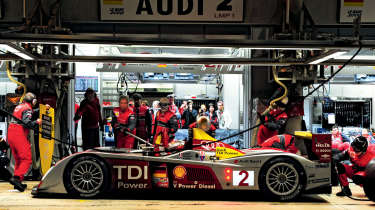GTL joins fuel race
Why diesel engines running gas-to-liquids fuels could be the answer
Forecasters predict that by the year 2050 the current world population of 6.5 billion will have grown to 9 billion and today’s global garage of 900 million cars will have expanded to 2 billion. Whilst electric and hydrogen cars are advancing in leaps and bounds, the truth is that, for the immediate future, mobility will rely on the internal combustion engine in some form or other.
Nonetheless, there is still pressure to reduce CO2 and seek alternative ways of fuelling such engines. Bio-ethanol, bio-diesel and LPG are obviously among the alternatives, but Shell has been working on something else – and, without realising, you may have already used it in your car. High in a grandstand at this year’s Le Mans 24 hours, we met up with Jack Jacometti, Vice President Future Fuels & CO2, to find out more.
Shell provides all the fuel for the 24-hour race, but it’s the diesel in the Peugeots and Audis that we’re interested in, because it contains GTL – Gas to Liquids. GTL behaves like diesel yet is colourless, odourless and virtually sulphur-free. It also burns cleaner than diesel. GTL is currently used as a component part of V-Power Diesel (hence why you may have already at least partially filled-up with it) but it can be used as a fuel in its own right in diesel engines without the need for any modifications.
GTL originates as natural gas but, unlike LPG, it can be transported and dispensed using the fuel infrastructure currently in place. It is produced in a three-stage process. The natural gas is oxidised into a synthesis gas (syngas) containing hydrogen and carbon monoxides. This is then converted into liquid hydrocarbons via a process called Fischer-Tropsch Synthesis. Finally, the liquid hydrocarbons are split (hydrocracked) into a range of products, including GTL fuel.
The reason GTL is good as a component part of V-Power Diesel – and the diesel used in the Le Mans cars whooshing along below us – is because it has a higher cetane number (the rating of how well diesel ignites under compression), meaning smoother engine performance and potentially quieter running.
So, if cars running on GTL have been shown to produce 25 to 40 per cent fewer particulates and 40 to 85 per cent less carbon monoxide compared with diesel – which they have – why is GTL not rapidly replacing diesel? Because, unfortunately, the higher level of CO2 produced in the manufacture of GTL negates the reduced emissions emerging from exhaust pipes, meaning its ‘well to wheel’ CO2 levels are roughly the same as diesel.
A technological dead-end then? Not quite, because as Jacometti explains, not only is there the potential to make the manufacturing process more carbon-efficient by up to 30 per cent, but something called BTL – Biomass to Liquids – is also currently under development by Shell with a German company called CHOREN.
BTL produces the same end fuel, but instead of using up natural gas, the initial gas supply is garnered by burning renewable biomass (residues or organic wastes such as short rotation trees, perennial grasses, straw, forest thinnings, bark from paper-pulp production, waste paper or reclaimed wood) thus making the whole process 90 per cent carbon neutral. A facility to produce BTL commercially is due to open in 12 months and some BTL was even blended (along with GTL) into the diesel used in the Le Mans cars.
Ultimately, of course, both GTL and BTL work in a diesel rather than petrol fashion, and in some people’s view this makes it as unexciting as the Audi R10’s engine note. However, if the choice in 20 years’ time is between a G‑Whiz or a BMW 335d, the case for it looks a little more attractive…




